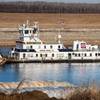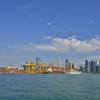U.S. Builders Make Waves At Year End
While consolidations and closures continue to reshape the ship and boatbuilding industry worldwide, 1999 ended on some positive notes, particularly for ship and boat building companies in the United States. U.S. builders, who have watched U.S. Navy business dwindle for more than a decade, have – with the help of the U.S. Maritime Administration – invested hundreds of millions of dollars and an endless amount of effort to restructure their shipyard’s structures, machinery and work flows. The result: a smaller but more capable base of companies that are geared to fulfill demands of traditional clients down the block as easily as they fulfill the demands of customers around the world. The efforts of many U.S. yards have been detailed in the pages of Maritime Reporter & Engineering News for decades. A recent swing through the vibrant Gulf of Mexico region, however, helped quantify the level and expediency of change. Processing steel in a more effective, efficient and environmentally responsible manner has gone straight from the planning committee to real-world applications, and many of the GOM area yards currently have or will soon get some of the most innovative steel processing and cutting facilities in the world. From Steiner Shipyard’s new subsidiary company – Enviro-Metals – in Bayou La Batre, Ala., to Bender’s new First Operations Shop in Mobile, Ala, to Litton-Avondale’s now thoroughly proven steel processing facility and Bollinger’s enhanced capabilities, yards large and small have studied, emulated and improved on some of the world’s premiere ship and boat building installations.
Prospects: 2000 and Beyond
While, by sheer number of dollars, the year 1999 may have not shaped up to be a record one for U.S. ship and boatbuilders, from a perception standpoint the industry advanced by leaps and bounds, particularly during the last four months or so. There has been a steady stream of unique and technically challenging orders being placed and beginning progress in U.S. yards of all shapes and sizes.
Last year saw arguably the most significant new passenger ship order in U.S. history when American Classic Voyages’ (AMCV) contracted with Litton’s Ingalls Shipbuilding to build the first U.S.-flag cruise ships in more than 40 years. The $1.4-billion Project America ship is for two 1,900-passenger vessels, scheduled for delivery in 2003 and 2004. The fleet will sail under the United States Lines company name, will operate weekly cruises to the U.S. Hawaiian Islands.
San Diego-based National Steel and Shipbuilding Company (NASSCO) -- a General Dynamics company -- has had its hand in an number of interesting projects, most recently winning a $300 million contract to build two RoRo vessels for Totem Ocean Trailer Express (TOTE) of Anchorage, Alaska. NASSCO will build two 839 ft. (255.7 m) RoRo vessels for its Alaska service. According to Robert P. Magee, TOTE's president and CEO, "This $300 million private investment will further our commitment to Alaskans well into the next century by enhancing Alaskan job opportunities on our vessels and shoreside."
"These ships, which carry more than 50 percent more cargo than our present ships, are designed specifically to endure the harsh conditions of the Alaska trade," Magee added.
The new vessels will be the same size as TOTE's existing three ships, "while maintaining extra capacity to fulfill any surge cargo needs and allow for seamless service during dry docks," Magee furthered.
In the first part of the year, NASSCO signed a Memorandum of Understanding for the building of the first generation high-speed vessels comprised of the FastShip trans-Atlantic transportation fleet. FastShip is a gas turbine powered vessel concept that aims to economically fill the void between air transport and traditional ship transport. Under the proposed agreement, NASSCO, designer and builder of new ships headquartered in San Diego, will construct four revolutionary vessels in the FastShip fleet. The agreement establishes a timeline to finalize a construction contract to include definitive pricing, delivery schedule and performance guarantees. NASSCO has also agreed to consider a financing commitment to FastShip, Inc. Powered by five marinized aero-derivative gas turbines, each turbine will drive one Kamewa water jet, delivering a total of 250 MW or 335,000-hp.
Earlier in the fall NASSCO was named the prime contractor on $17.4 million in research and development contracts awarded by the MARITECH Advanced Shipbuilding Enterprise (ASE) Program.
In addition to the funds awarded by MARITECH, industry participants will invest $23.5 million of their own funds in the projects for a total program cost of $40.9 million.
NASSCO will lead a team of U.S. shipbuilders, marine design and technology firms, and universities on two three-year projects to develop advanced systems for the construction of Navy and commercial ships.
In mid-December, NASSCO launched USNS CHARLTON, the fifth strategic sealift ship being built for the U.S. Navy by NASSCO. Measuring 950 x 105 ft. (290 x 32 m), the strategic sealift ships are the largest ships ever launched down a sliding ways in the U.S.
TOTE RoRo Ship Main Particulars
Shipbuilder NASSCO
Shipowner TOTE
Contract Price $300 million
No. Ships 2
First Delivery 2002
Length, (o.a) 839 ft. (256 m)
Length, (b.p.) 792 ft. (241 m)
Beam, (molded) 118 ft. (36 m)
Draft, (design) 30 ft. (9.1 m)
Draft, (scantling) 32 ft. (9.7 m)
Displacement 45,400 long tons
Deadweight 20,800 long tons
Trial speed 24 knots
Halter Marine Launches Delta Mariner
Halter Marine, Inc., the marine vessel division of Friede Goldman Halter, Inc., late last month christened and launched the M/V Delta Mariner, designed and built for Foss Maritime Company on behalf of The Boeing Company, at the Halter Moss Point shipyard on the Escatawpa River.
The Delta Mariner will transport Boeing-built Delta IV rocket boosters from Decatur, Alabama to Cape Canaveral, Fla. and Vandenberg Air Force Base in California, for participation in the Evolved Expendable Launch Vehicle (EELV) program. The EELV program is a multi-year effort designed to reduce space launch costs by 25 percent.
The vessel’s sponsor was Patricia G. Smith, the Federal Aviation Administration’s Associate Administrator for Commercial Space Transportation. The vessel is 310 ft. (94.4) long, has a beam of 82 ft. (24.9 m), and is powered by a pair of 4,000 hp diesel engines. A unique feature of the DELTA MARINER is its dual mode design that enables it to operate in a shallow draft mode while in rivers and then ballast down to a deep draft mode for ocean passages. This variable ballasting system is incorporated with a stern-mounted ramp into the vessel's RoRo loading system. This design enables the smooth loading of aerospace hardware on and off the ship.
Alabama Launches Milestone ATB
Alabama Shipyard is hoping that last month’s launching of its unique Articulated Tug Barge unit (ATB) for Reinauer Transportation signals the beginning of many more orders for the OPA 90 compliant product transporters. The company estimates that 50 single hull barges will need replacements by 2005, and the yard is expanding its market horizons by, for example, holding discussions with owners who are evaluating using the ATB as a shuttle tanker in the Gulf of Mexico.
The 460-ft. (140.2 m) barge, designed by Alabama shipyard, is double-hulled and in compliance with the OPA 90 regulations. Bob Hill of Ocean Tug and Barge Engineering designed the 7,200-hp, 124-ft (37.7 m) tug, which was built at Atlantic Marine-Jacksonville.
The ocean-going tug/barge unit offers the patented Intercon tug/barge coupler system, which was designed and built by Intercontinental Engineering and Manufacturing of Kansas City, Mo.
Alabama Shipyard designed the barge itself, and offers the unit in a variety of capacities and configurations. In addition, since it was designed by the yard, the barge units take full advantage of Alabama’s modern facilities and advanced building system, allowing the unit to be priced very competitively. For example, the barge utilizes the shipyard’s modular construction techniques, as the main hull consists of just five main pieces. There is also less than two percent compound curvature in the hull, a design feature that makes construction, repair and maintenance easier.
The shipyard used Foran 3-D modeling, allowing, for example, the pipeshop to manufacture the piping with flanges, which simplifies pipe installation and allows it to be bolted directly in place.
The intention for future orders is to build the tugs at Alabama Shipyard as well, in order to fully realize the building capabilities of the bigger shipyard, which features far more lifting capacity, for example, than the Jacksonville facility. The end goal of the ATB program is to realize the many cost and efficiency benefits of series production, and Alabama Shipyard officials estimate that once production is fully up and running, that it will be able to build between 8 and 12 tug/barge units per year.






